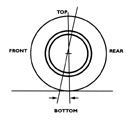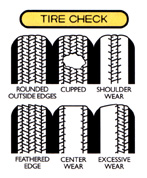| What is an alignment?
Alignment refers to the way your car's wheels are positioned. Your wheels should be parallel and facing forward.
How does an alignment affect my vehicle?
When your wheels are properly aligned, you'll get better gas mileage, your tires will last longer, steering will be easier, and your ride will be smoother and safer.
What could go wrong with my alignment?
Several factors could contribute to a shift in alignment including old, worn-out components and poor road conditions, resulting in a few different problems including Camber, Toe and Caster, and if any of these problems develop, they will take a toll on your vehicle's tires, performance and manageability.
|
|
Camber
 The wheels are tilted, either
The wheels are tilted, either
inward or outward. This will
create pulling and tire wear.
Toe
 A change in the distance between
A change in the distance between
the front and back of the front or rear
tires. This will wear on the tires, too.
Caster
 A backward or forward tilt at the top of the wheel's spindle support arm. This will cause either loose or difficult steering.
A backward or forward tilt at the top of the wheel's spindle support arm. This will cause either loose or difficult steering.
If any of these problems develop, they will begin to take their toll on your car's tires and performance, as well as steering manageability. |
How will I recognize a problem with my alignment?
Check your steering wheel when you're driving. Does it stay straight? Does it vibrate? When you are traveling along a straight road, does your vehicle pull to one side? Is your steering loose, or difficult to control? Have you noticed uneven tire wear?
Check your tires periodically using this chart. A number of different things can affect your tires - from alignment to suspension components to improper inflation of tires. If you recognize any of these symptoms, bring your car in for a free inspection.
How will Cars of Sarasota fix my alignment?
As a general rule, you should have your alignment and related components checked every 10,000 miles or once a year, and there are three types of alignment jobs with a good-better-best approach.
GOOD
Two-wheel geometric centerline
alignment.
This adjusts the toe on your front wheels only. This will work only if your rear wheels are properly aligned. (Used mostly on trucks and older rear-wheel drive cars).
BETTER
Four-wheel thrust line alignment.
This aligns the front wheels to the rear-wheel alignment.
BEST
Complete four-wheel thrust line alignment.
This is the optimal approach: aligning all wheels straight ahead and parallel.
After a thorough review of your alignment, our technician will present you with the findings and all of your options before beginning any work on your vehicle.
|

 The wheels are tilted, either
The wheels are tilted, either  A change in the distance between
A change in the distance between A backward or forward tilt at the top of the wheel's spindle support arm. This will cause either loose or difficult steering.
A backward or forward tilt at the top of the wheel's spindle support arm. This will cause either loose or difficult steering.